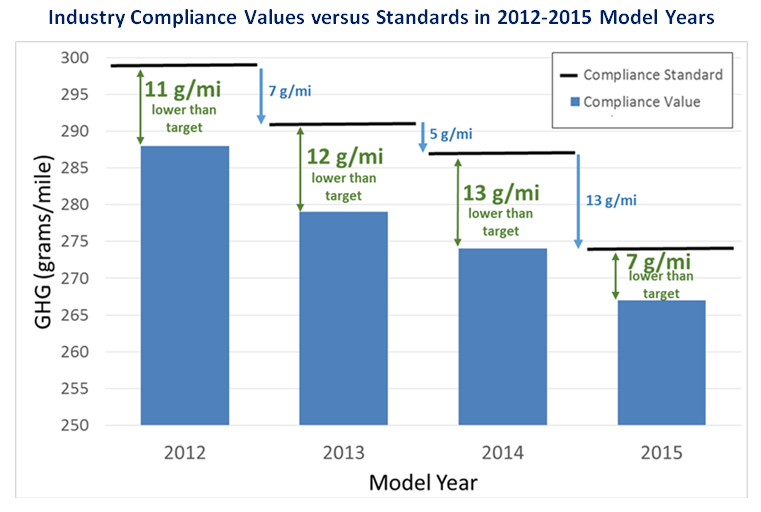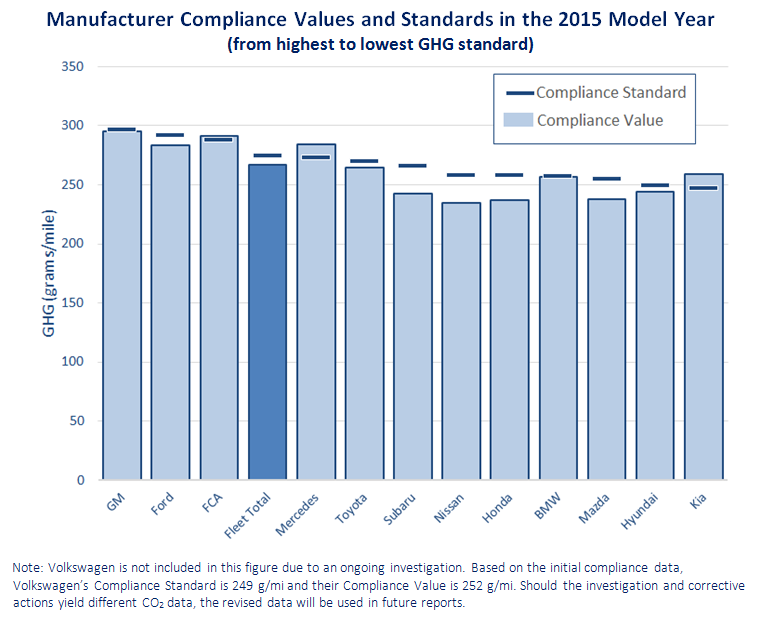Greenhouse Gas (GHG) Emission Standards for Light-Duty Vehicles: Manufacturer Performance Report
Overview
EPA and the National Highway Traffic Safety Administration (NHTSA) jointly established a National Program consisting of standards for light-duty vehicles that reduce greenhouse gas (GHG) emissions and improve fuel economy.
EPA’s GHG rules for light-duty vehicles require compliance with progressively more stringent GHG emission standards for the 2012 through 2025 model years.
The annual GHG Performance Report formally documents the status of auto company compliance with the GHG standards since the standards took effect in the 2012 model year.
- All data are based on annual production volumes of passenger cars and light trucks reported to EPA.
- The report includes detailed information on compliance, including the manufacturers’ use of credits and credit transactions.
- The report maintains transparency, allowing the public to monitor implementation and progress.
Key Findings
1. For the fourth consecutive year, the auto industry outperformed the GHG standard by a substantial margin
Overall industry performance in model year 2015 was 7 g/mi of GHG emissions better than required by the 2015 GHG emissions standard. This marks the fourth consecutive model year of industry outperforming the standards by a sizeable margin. This industry-wide performance means that manufacturers are offering and consumers continue to buy vehicles with lower GHG emissions than required by the EPA standards. See Section 3 for more detail on these values.* Manufacturers continued this level of performance against standards that increased dramatically in stringency in model year 2015. The standards increased in stringency by 13 g/mi; to put this in perspective, the total cumulative increase in stringency since the start of the program was 25 g/mi. Although the "compliance margin" narrowed to 7 g/mi, this remains notable in the face of a continuing increase in truck market share combined with the increased stringency.

* Although rounding of the values on the chart may produce some apparent inconsistencies, the numbers reported are correct.
2. Most manufacturers outperformed their individual 2015 standard
Most large manufacturers achieved fleet GHG compliance values equal to or lower than required by their unique 2015 standard. Nine of the twelve manufacturers with sales greater than 150,000 vehicles reported meeting or beating their standard, with margins of compliance ranging from 23 g/mi (Nissan and Subaru) to exactly meeting their standard with no margin (BMW). Three manufacturers (FCA, Mercedes, and Kia) missed their unique 2015 standards by 3, 11, and 12 g/mi, respectively, thus generating net deficits in the 2015 model year. More detail about model year 2015 performance is provided in Section 3. The figure below does not include the impact of credit transfers (within a company) reported from prior model years or reported credit trades (transactions between companies), and thus does not necessarily portray whether or not a manufacturer has complied with 2015 model year standards. The manufacturers that did not outperform their 2015 standard in fact have reported sufficient credits from prior model years to be in compliance with their respective 2015 model year standards.

3. All large manufacturers are in compliance with the 2012-2015 GHG standards
The majority of manufacturers, representing more than 99 percent of 2015 model year U.S. sales, have reported compliance with the standards for the 2012-2015 model years. In fact, 19 of 20 manufacturers are reporting a positive credit balance going into the 2016 model year, meaning that these manufacturers have met the standards in all of the 2012-2015 model years (credits cannot be carried forward if a deficit exists in a prior model year). Manufacturers are allowed to carry deficits forward for three model years. Thus, a manufacturer with a deficit from the 2012 model year must have offset that deficit by the end of the 2015 model year, or else be subject to possible enforcement action. All manufacturers that reported a deficit in the 2012 model year have successfully offset that deficit, thus no manufacturer is in a position of non-compliance at the end of the 2015 model year. The makeup of these credit and deficit balances is tracked by model year “vintage” as explained in Section 5.
Credit Balances at Conclusion of the 2015 Model Year (Mg)1
(including credit transfers & trades) 2
| Manufacturer | Credits Carried to 2016 |
|---|---|
| Toyota | 82,996,367 |
| Honda | 38,347,521 |
| GM | 31,060,500 |
| Ford | 30,604,147 |
| Nissan | 24,561,976 |
| FCA | 21,918,309 |
| Hyundai | 20,338,163 |
| Subaru | 13,281,040 |
| Mazda | 8,180,592 |
| Kia | 8,173,661 |
| BMW | 3,558,682 |
| Mitsubishi | 1,681,499 |
| Manufacturer | Credits Carried to 2016 |
|---|---|
| Mercedes 3 | 629,434 |
| Suzuki 5 | 428,242 |
| Fisker 5 | 46,694 |
| BYD Motors 5 | 4,824 |
| Tesla | 576 |
| Coda 5 | 0 |
| Volvo 3 | 0 |
| Jaguar Land Rover 3 | -288,555 |
| Aston Martin 3,4 | N/A |
| Ferrari 3,4 | N/A |
| Lotus 3,4,5 | N/A |
| McLaren 3,4 | N/A |
| All Manufacturers | 285,523,672 |
2 This table does not include unused credits from the 2009 model year, which expired at the end of the 2014 model year. See Section 2 for more information.
5 Although these companies produced no vehicles for the U.S. market in the most recent model year, the credits generated in previous model years continue to exist.
You will need Adobe Reader to view some of the files on this page. See EPA’s About PDF page to learn more.
2014 Model Year Report
- GHG Emission Standards for Light-Duty Vehicles: Manufacturer Performance Report for the 2014 Model Year (PDF) (93 pp, 2 MB, EPA-420-R-15-026, December 2015)
